IOL exchange: Technique and surgical pearls
A case illustrates an IOL exchange after iatrogenic IOL optic damage in an otherwise uncomplicated cataract surgery.
IOL implantation requires proper seating of the IOL within the lens capsular bag, with good IOL centration and without any contact with the adjacent tissues such as the iris. Repeated mechanical rubbing of the IOL against the iris tissue can result in secondary inflammation such as iritis, synechiae formation, pupillary distortion, secondary glaucoma and even macular edema with decreased postoperative vision. The indications for an IOL exchange include:
- Incorrect IOL power calculations preoperatively.
- Optical aberrations interfering with the patient’s daily activities.
- Subluxated and dislocated IOL.
- IOL opacification causing visual symptoms.
- Damaged IOL with ongoing secondary adjacent tissue damage and/or visual symptoms.
In this column, I describe the surgical technique of IOL exchange in a referred patient, with IOL optic damage during surgery, and present some surgical pearls for IOL exchange.
Case description

Figure 1. A preoperative slit lamp view of a significantly damaged optic of a posterior chamber acrylic IOL. Clearly seen is a circumlinear IOL optic tear, with a resultant optic segment that is anteriorly displaced and separated from the remainder of the IOL optic. Additional areas of optic damage are visible under the red reflex. Also seen is a wrinkled, fibrotic posterior lens capsule with radial fibrotic ridges extending from an inferior nodal point to the periphery of the lens capsular bag.

Figure 2. Higher magnification view of the region of the damaged IOL optic.
Images: John T
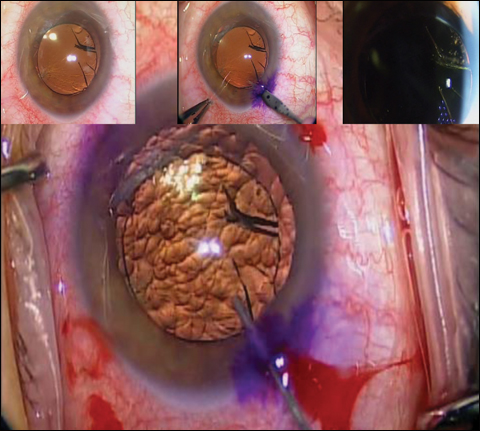


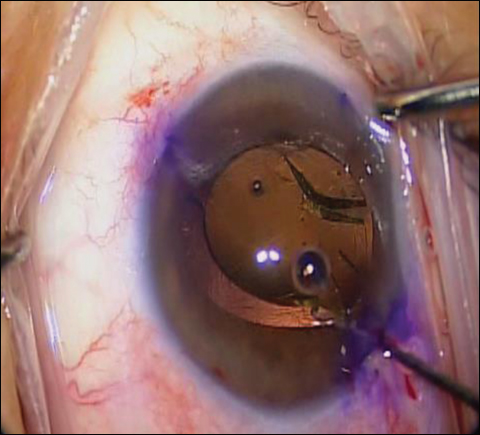
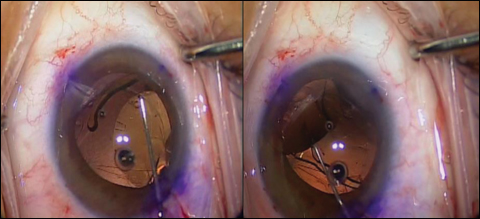

A 72-year-old Caucasian man was referred for possible IOL exchange after iatrogenic IOL optic damage in an otherwise uncomplicated cataract surgery by the referring ophthalmologist. The IOL optic was partially torn in multiple locations, and the anteriorly displaced IOL optic segment (Figures 1 and 2) rubbed on the iris, causing ongoing anterior uveitis, red eye, photophobia, discomfort, blurred vision, difficulty driving a car at night and an updrawn, distorted pupil. Uncorrected vision was 20/60 with normal IOP. The patient required an IOL exchange.
Surgical technique
The anterior chamber is entered through the peripheral clear cornea using a 15° superblade, and a dispersive viscoelastic, Viscoat (chondroitin sulphate and sodium hyaluronate, Alcon), is injected to fill the anterior chamber (Figure 3). Using a blunt hook, the IOL optic edge is gently lifted to assess the degree and extent of adherence between the IOL and the lens capsular bag (Figure 4). It is important to release all IOL-capsular adhesion before any IOL rotation to prevent any zonular damage and/or capsular tear.
Using a bent 30-gauge needle with the bevel facing down and attached to the Viscoat syringe, the anterior capsular rim is gently separated from the anterior IOL optic surface by viscodissection, as described by Uday Devgan, MD, and others. The needle is then introduced from the opposite entry site, and the same maneuver is repeated to ensure 360° of capsular separation from the IOL before any IOL rotation (Figure 5). Once the IOL is freed from its anterior capsular attachments 360°, the IOL optic is gently lifted and Viscoat is injected posteriorly into the capsular bag (Figure 6). Using a blunt hook, the IOL haptics are released from the posterior lens capsule, and the lens is gently brought into the anterior chamber, taking care not to damage the corneal endothelium or the posterior lens capsule (Figure 7).
The IOL is then fully seated within the anterior chamber with haptics over the anterior iris surface (Figure 8). The optic is stabilized with micro-forceps, and the IOL optic is cut using micro-scissors after filling the anterior and posterior regions with Viscoat (Figure 9). Viscoat is then injected between the two optic segments, thus providing a working space. The anterior optic segment is suspended in Viscoat, away from the corneal endothelium, while the posterior optic segment rests on the iris surface (Figure 10). Working between the IOL segments, the larger posterior IOL optic is then cut longitudinally or trisected, resulting in three IOL optic segments (Figure 11). The three IOL optic segments are removed, while replenishing Viscoat in between IOL segment removal to protect both the posterior lens capsule and the corneal endothelium and to avoid any potential iris damage (Figure 12).
A three-piece posterior chamber IOL is introduced into a Viscoat-filled anterior chamber. The lens unfolds with the posterior surface facing anteriorly. Hence, the IOL is flipped on its longitudinal axis under Viscoat using two instruments (Figure 13), and then the haptics are placed in the ciliary sulcus. A well-centered posterior chamber IOL is seen at the end of the procedure (Figure 13).
Postoperatively, the patient was asymptomatic and pleased with the surgical result. Figure 14 shows a clear and compact cornea without corneal edema and a round pupil on day 4 after surgery. Figure 15 shows the view at 3.5 weeks after surgery, displaying a well-centered sulcus-seated posterior chamber IOL and an intact posterior capsule. The patient’s vision improved to 20/25 with correction, there was no iritis, and he was free of his ocular symptoms.
Surgical pearls
1. Use adequate dispersive viscoelastic such as Viscoat to protect the corneal endothelium and the posterior lens capsule.
2. Assess the amount of IOL attachment to the lens capsule before any significant IOL manipulations. It is important to release all IOL-capsular adhesion before any IOL rotation to prevent potential zonular damage and/or capsular tear.
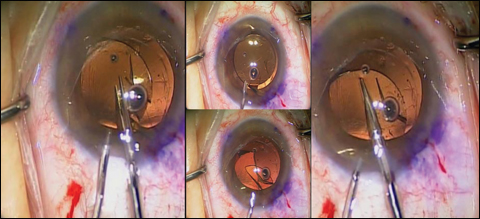
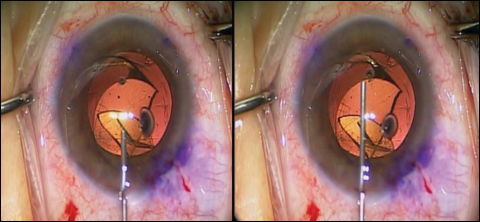



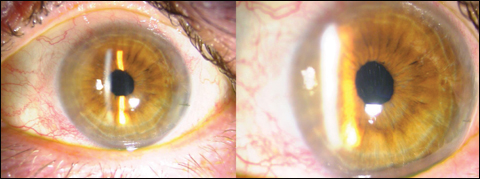

3. Once the IOL is free of all capsular adhesions, it can be gently rotated and introduced into the anterior chamber.
4. Use plenty of Viscoat during intraocular manipulations to protect the corneal endothelium and the lens capsule at all times.
5. Trisecting the lens is possible when there is enough working space, namely an adequately deep anterior chamber. Alternative techniques of IOL removal include folding the IOL within the anterior chamber and removing it; cutting the IOL optic from the periphery up to the optic center and then rotating it at the wound site; or bisecting the IOL before removal.
6. Stabilize the IOL optic with micro-forceps before cutting the optic with micro-scissors.
7. Amputate the IOL haptic only if all attempts at freeing the haptic-capsular adhesion fail.
8. A three-piece IOL is optimal for ciliary sulcus placement of the IOL. Unfold the IOL in the anterior chamber with the haptics over the iris surface. Then, using a hook, the haptics can be safely seated into the ciliary sulcus.
9. Do not place a single-piece foldable acrylic posterior chamber IOL in the ciliary sulcus.
10. If the IOL unfolds in an undesired position, it can be rotated on its long axis using two instruments, as in this case before ciliary sulcus placement.
- References:
- Galor A, et al. J Cataract Refract Surg. 2009;doi:10.1016/j.jcrs.2009.05.022.
- Hayashi K, et al. Graefes Arch Clin Exp Ophthalmol. 2016;doi:10.1007/s00417-016-3273-6.
- Ní Dhubhghaill S, et al. J Cataract Refract Surg. 2015;doi:10.1016/j.jcrs.2015.04.006.
- Oltulu R, et al. Arq Bras Oftalmol. 2015;doi:10.5935/0004-2749.20150040.
- For more information:
- Thomas “TJ” John, MD, a clinical associate professor at Loyola University Chicago and in private practice in Oak Brook, Tinley Park and Oak Lawn, Ill., can be reached at tjcornea@gmail.com.
Disclosure: John reports no relevant financial disclosures.
